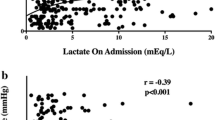Abstract
Purpose
Despite the utility of serum lactate for predicting clinical courses, little information is available on the topic after decompressive craniectomy. This study was conducted to determine the ability of perioperative serum lactate levels to predict in-hospital mortality in traumatic brain-injury patients who received emergency or urgent decompressive craniectomy.
Methods
The medical records of 586 consecutive patients who underwent emergency or urgent decompressive craniectomy due to traumatic brain injuries from January 2007 to December 2014 were retrospectively analyzed. Pre- and intraoperative serum lactate levels and base deficits were obtained from arterial blood gas analysis results.
Results
The overall mortality rate after decompressive craniectomy was 26.1 %. Mean preoperative serum lactate was significantly higher in the non-survivors (P = 0.034) than the survivors but had no significance for predicting in-hospital mortality in the multivariate regression analysis (P = 0.386). Rather, preoperative Glasgow Coma Score was a significant predictor for in-hospital mortality (hazard ratio 0.796, 95 % confidence interval 0.755–0.836, P < 0.001).
Conclusion
Preoperative lactate level is not an independent predictor of in-hospital mortality after decompressive craniectomy in traumatic brain-injury patients.


Similar content being viewed by others
References
Murray GD, Teasdale GM, Braakman R, Cohadon F, Dearden M, Iannotti F, Karimi A, Lapierre F, Maas A, Ohman J, Persson L, Servadei F, Stocchetti N, Trojanowski T, Unterberg A. The European Brain Injury Consortium survey of head injuries. Acta Neurochir (Wien). 1999;141:223–36.
Polin RS, Shaffrey ME, Bogaev CA, Tisdale N, Germanson T, Bocchicchio B, Jane JA. Decompressive bifrontal craniectomy in the treatment of severe refractory posttraumatic cerebral edema. Neurosurgery. 1997;41:84–92 (Discussion 92–94).
McIntosh TK, Faden AI, Bendall MR, Vink R. Traumatic brain injury in the rat: alterations in brain lactate and pH as characterized by 1H and 31P nuclear magnetic resonance. J Neurochem. 1987;49:1530–40.
Makoroff KL, Cecil KM, Care M, Ball WS Jr. Elevated lactate as an early marker of brain injury in inflicted traumatic brain injury. Pediatr Radiol. 2005;35:668–76.
Régnier MA, Raux M, Le Manach Y, Asencio Y, Gaillard J, Devilliers C, Langeron O, Riou B. Prognostic significance of blood lactate and lactate clearance in trauma patients. Anesthesiology. 2012;117:1276–88.
Husain FA, Martin MJ, Mullenix PS, Steele SR, Elliott DC. Serum lactate and base deficit as predictors of mortality and morbidity. Am J Surg. 2003;185:485–91.
Mikkelsen ME, Miltiades AN, Gaieski DF, Goyal M, Fuchs BD, Shah CV, Bellamy SL, Christie JD. Serum lactate is associated with mortality in severe sepsis independent of organ failure and shock. Crit Care Med. 2009;37:1670–7.
Paladino L, Sinert R, Wallace D, Anderson T, Yadav K, Zehtabchi S. The utility of base deficit and arterial lactate in differentiating major from minor injury in trauma patients with normal vital signs. Resuscitation. 2008;77:363–8.
Inao S, Marmarou A, Clarke GD, Andersen BJ, Fatouros PP, Young HF. Production and clearance of lactate from brain tissue, cerebrospinal fluid, and serum following experimental brain injury. J Neurosurg. 1988;69:736–44.
Alves JL. Blood–brain barrier and traumatic brain injury. J Neurosci Res. 2014;92:141–7.
Chodobski A, Zink BJ, Szmydynger-Chodobska J. Blood–brain barrier pathophysiology in traumatic brain injury. Transl Stroke Res. 2011;2:492–516.
Callaway DW, Shapiro NI, Donnino MW, Baker C, Rosen CL. Serum lactate and base deficit as predictors of mortality in normotensive elderly blunt trauma patients. J Trauma. 2009;66:1040–4.
Abramson D, Scalea TM, Hitchcock R, Trooskin SZ, Henry SM, Greenspan J. Lactate clearance and survival following injury. J Trauma. 1993;35:584–8.
Shallwani H, Waqas M, Waheed S, Siddiqui M, Froz A, Bari ME. Does base deficit predict mortality in patients with severe traumatic brain injury? Int J Surg. 2015;22:125–30.
Zehtabchi S, Sinert R, Soghoian S, Liu Y, Carmody K, Shah L, Kumar M, Lucchesi M. Identifying traumatic brain injury in patients with isolated head trauma: are arterial lactate and base deficit as helpful as in polytrauma? Emerg Med J. 2007;24:333–5.
Odom SR, Howell MD, Silva GS, Nielsen VM, Gupta A, Shapiro NI, Talmor D. Lactate clearance as a predictor of mortality in trauma patients. J Trauma Acute Care Surg. 2013;74:999–1004.
Davis DP, Serrano JA, Vilke GM, Sise MJ, Kennedy F, Eastman AB, Velky T, Hoyt DB. The predictive value of field versus arrival Glasgow Coma Scale score and TRISS calculations in moderate-to-severe traumatic brain injury. J Trauma. 2006;60:985–90.
Ting HW, Chen MS, Hsieh YC, Chan CL. Good mortality prediction by Glasgow Coma Scale for neurosurgical patients. J Chin Med Assoc. 2010;73:139–43.
Udekwu P, Kromhout-Schiro S, Vaslef S, Baker C, Oller D. Glasgow Coma Scale score, mortality, and functional outcome in head-injured patients. J Trauma. 2004;56:1084–9.
Saika A, Bansal S, Philip M, Devi BI, Shukla DP. Prognostic value of FOUR and GCS scores in determining mortality in patients with traumatic brain injury. Acta Neurochir (Wien). 2015;157:1323–8.
Herbert HK, Dechert TA, Wolfe L, Aboutanos MB, Malhotra AK, Ivatury RR, Duane TM. Lactate in trauma: a poor predictor of mortality in the setting of alcohol ingestion. Am Surg. 2011;77:1576–9.
Author information
Authors and Affiliations
Corresponding author
Ethics declarations
Conflict of interest
The authors have no competing interests to declare.
About this article
Cite this article
Jo, Y.Y., Kim, J.Y., Choi, J.J. et al. Preoperative serum lactate cannot predict in-hospital mortality after decompressive craniectomy in traumatic brain injury. J Anesth 30, 637–643 (2016). https://doi.org/10.1007/s00540-016-2169-2
Received:
Accepted:
Published:
Issue Date:
DOI: https://doi.org/10.1007/s00540-016-2169-2




